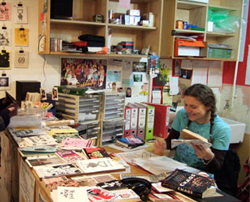Melbourne, Australia’s Sticky Institute knows zines.
“I try to read literally every zine that comes through our doors,” manager Luke Sinclair says. The distro, which opened its doors in April of 2001 after Melbourne artist Simone Ewenson visited a similar shop in Amsterdam, carries a variety of zines, “artist books,” and other independent publications. Through support from the Victorian government and the Australian Council for the Arts, Sticky is able to nurture independent artists at every stage of the process.
The distro, self-described as “an artist-run initiative fusing an exhibiting and open-resource working space with a non-profit retail environment, housed in Degraves Street Subway under Flinders Street, Melbourne,” provides a uniquely collaborative experience between staff and artist, reader and creator.
A zine-maker himself, Sinclair is very familiar with the joys and (financial) downsides of the process. “Very few zines make any money,” he says. “I have personally lost thousands of dollars on my various zine projects over the years, and it has been worth every cent.”
He defines a zine as something “made for love, not profit,” a phrase that could serve as a mission statement for the store. This spirit drives the creation of zines – a love of the printed word and the artistic process, not money and fame.
 Although Sticky offers important resources for artists, it has also created something much greater – a fun, intuitive, and innovative environment.
Although Sticky offers important resources for artists, it has also created something much greater – a fun, intuitive, and innovative environment.
Various activities have grown up around the Melbourne zine distro, from a thriving community of passionate volunteers and zine makers to events like February’s Festival of the Photocopier and an online “zineopedia” that keeps track of artists, titles, and other important contributions to Australian zine culture. Sticky Institute lists events for zine makers all over Australia and other distros, in addition to hosting monthly meetings of “The Opinion Society” and a few workshops of its own.
To Sinclair, independent media isn’t just cool; it’s a social necessity for creating a sort of alternate history. Individual expression is the only way to maintain control over one’s artistic vision, something that’s of utmost importance to the members of Sticky.
“Every time something I have been involved in has been represented by the mainstream media, it has been misrepresented,” Sinclair says. “So it is important that we tell our own stories and our own history, or else nobody else will.”
He’s practical in his expectations of personal storytelling, however. His advice to anyone who wants to make a zine? Trial and error. “Make terrible mistakes in your first issue and learn from them to improve your second issue,” he says. “And bring in ten copies of your zine to Sticky!”
– Mallory Gevaert
Zine Scene is a biweekly column about writers’ and artists’ adventures in the world of independent publishing.

